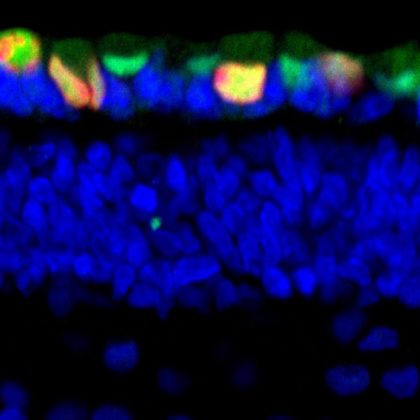Navigage, Rose Hills Foundations support Berenice Benayoun
From catching cognitive impairment earlier to understanding the genetics of age-related disease and health disparities, USC Leonard Davis School of Gerontology faculty conduct exciting research supported by organizations committed to helping others. …
$10 million gift from Broad Foundation advances USC stem cell research on aging-associated disease
USC’s groundbreaking stem cell research and training programs have received a major boost thanks to a $10 million gift from the Eli and Edythe Broad Foundation. The donation is part of the …
USC Stem Cell junior faculty balance babies with biomedical research
Growing stem cells isn’t just something junior faculty do in the lab. Eight of the junior faculty in the Department of Stem Cell Biology and Regenerative Medicine recently welcomed new babies into …
From restoring sight to reversing brain damage, USC stem cell researchers are making life-changing discoveries
If anyone has a clear vision of the power of stem cell cures, it’s Anna Kuehl. She suffered a retina-wrecking disease that cost her much of her sight before USC physicians surgically …
RSVP for 6/26 USC Public Symposium on a stem cell-based approach to treating age-related blindness
A Public Symposium co-sponsored by USC Stem Cell and the Choi Family @ISSCCR 2019 RSVP at https://www.eventbrite.com/e/bringing-stem-cells-to-patients-treating-age-related-blindness-tickets-62892259441#tickets Program *Spanish translation available. 6:30 p.m. Registration and free food 7–8 p.m. Andrew P. McMahon, …
Critical windows when experience shapes the brain
Story courtesy of Children’s Hospital Los Angeles Pat Levitt, PhD, Chief Scientific Officer at Children’s Hospital Los Angeles and Simms/Mann Chair in Developmental Neurogenetics, received a $3.7M grant from the National Institute …
This tiny fish could unlock mysteries about growing old
Back in its native habitat, the African turquoise killifish wiggles from its egg, eats, spawns and dies — all within a few months. Life goes by fast when your home is a …
Eat less, live longer? The science of fasting and longevity
When it comes to what, when and how we eat, fasting — voluntarily abstaining from food for varying periods of time — is having a moment. It was the most popular diet …
Neural development of 2-month-old infants shows effect of maternal stress
Story courtesy of Children’s Hospital Los Angeles A study of 70 mothers and their infants suggests that the impact of maternal stress on neurodevelopment is detectable by electroencephalography (EEG) at 2 months …
Bérénice Benayoun honored for genetics research
The Genetics Society of America (GSA) and the Gruber Foundation have awarded Assistant Professor Bérénice Benayoun the 2019 Rosalind Franklin Young Investigator Award for her research in genetics. The award, intended to …
What makes a cell turn cancerous?
Story courtesy of Children’s Hospital Los Angeles Retinoblastoma is a tumor of the retina that generally affects children under 5 years of age and accounts for approximately 4% of childhood cancers. If …
Stem cell scientist Giorgia Quadrato joins USC’s brain trust
Giorgia Quadrato loves a good challenge. That’s why USC’s newest assistant professor of stem cell biology and regenerative medicine currently spends her time growing 3D networks of human nerve cells, called brain …
USC Stem Cell acquires two instruments to advance state-of-the-art cell sorting
When it comes to sorting cells or other small particles, there’s no better place to do so than USC. The university’s Flow Cytometry Facility recently acquired two top-of-the-line cell sorters, the BD …
Innovators of USC: Justin Ichida stays at the forefront of ALS research
Justin Ichida keeps his research patient-based. That’s why Ichida, Richard N. Merkin, M.D., Assistant Professor of Stem Cell Biology and Regenerative Medicine at the Keck School of Medicine of USC, and his …
Disease risk seen in disrupted biological clock
USC scientists report that a novel time-keeping mechanism within liver cells that helps sustain key organ tasks can contribute to diseases when its natural rhythm is disrupted.
Ellis Meng and Mike Waterman elected fellows of the National Academy of Inventors
Ellis Meng, a professor of biomedical engineering and electrical engineering, who holds the Gabilan Distinguished Professorship in Science and Engineering at the USC Viterbi School of Engineering, and University Professor, Michael Waterman, …
TIME names Valter Longo one of the 50 Most Influential People in Health Care of 2018
USC Leonard Davis School Professor Valter Longo, director of the USC Longevity Institute and USC Stem Cell principal investigator, has been named one of TIME’s the 50 Most Influential People in Health …
Out of the woods: USC alumna and nature lover Anna Kuehl finds hope to restore her vision
Once upon a time, there was a little girl named Anna Kuehl who loved exploring the nature surrounding her home in the Bavarian Forest. Located northeast of Munich not far from the …
USC Stem Cell scientist Andy McMahon and collaborators tune into the organ concert
Every minute of every day, your organs are using a complex language to communicate with each other about the basic physiological processes necessary for life—everything from blood pressure regulation to pH balance …
CHLA team identifies developmental stage for eye tumor in children
Investigators at Children’s Hospital Los Angeles have been able to pinpoint the exact stage of development of the human retina, when cells can grow out of control and form cancer-like masses. The …


















